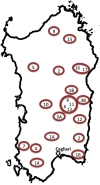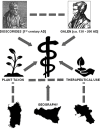From cumulative cultural transmission to evidence-based medicine: evolution of medicinal plant knowledge in Southern Italy
- PMID: 26483686
- PMCID: PMC4588697
- DOI: 10.3389/fphar.2015.00207
From cumulative cultural transmission to evidence-based medicine: evolution of medicinal plant knowledge in Southern Italy
Abstract
In Mediterranean cultures written records of medicinal plant use have a long tradition. This written record contributed to building a consensus about what was perceived to be an efficacious pharmacopeia. Passed down through millennia, these scripts have transmitted knowledge about plant uses, with high fidelity, to scholars and laypersons alike. Herbal medicine's importance and the long-standing written record call for a better understanding of the mechanisms influencing the transmission of contemporary medicinal plant knowledge. Here we contextualize herbal medicine within evolutionary medicine and cultural evolution. Cumulative knowledge transmission is approached by estimating the causal effect of two seminal scripts about materia medica written by Dioscorides and Galen, two classical Greco-Roman physicians, on today's medicinal plant use in the Southern Italian regions of Campania, Sardinia, and Sicily. Plant-use combinations are treated as transmissible cultural traits (or "memes"), which in analogy to the biological evolution of genetic traits, are subjected to mutation and selection. Our results suggest that until today ancient scripts have exerted a strong influence on the use of herbal medicine. We conclude that the repeated empirical testing and scientific study of health care claims is guiding and shaping the selection of efficacious treatments and evidence-based herbal medicine.
Keywords: De Materia Medica; causal effect; cultural transmission and evolution; evidence-based; globalization; herbal medicine; historical ethnopharmacology; traditional medical knowledge.
Figures






References
-
- Amico F. P., Sorge F. G. (1997). Medicinal plants and phytotherapy in Mussomeli area (Caltanissetta, Sicily, Italy). Fitoterapia 68, 143–159.
-
- Arber A. (1953). Herbals, their Origin and Evolution. A Chapter in the History of Botany. Cambridge, MA: Cambridge University Press.
-
- Arcidiacono S., Napoli M., Pavone P. (1999). Piante selvatiche utilizzate nella medicina e nella veterinaria popolare nel territorio di Bronte (Catania). Quad. Bot. Ambientale Appl. 10, 105–118.
-
- Arcidiacono S., Napoli M., Oddo G., Pavone P. (2007). Piante selvatiche d'uso popolare nei territori di alcara li fusi e militello rosmarino (Messina, N-E Sicilia). Quad. Bot. Amb. Appl. 18, 103–144.
LinkOut - more resources
Full Text Sources
Other Literature Sources
Miscellaneous

